Using Time-Series Videos to Quantify Methane Bubbles Flux from Natural Cold Seeps in the South China Sea
Abstract
1. Introduction
2. Study Areas
2.1. Site F
2.2. Haima
3. Methods
3.1. CTD and Methane Sensor
3.2. Camera Properties and Deployment
3.3. Bubble Size Measurements
3.4. Semi-Automatic Bubble Counting Algorithm
4. Results
4.1. Ambient Conditions
4.2. Gas Bubble Characteristics
4.3. Bubble Measurements and Rates
4.4. Methane Bubble Flux
5. Discussion
5.1. Temporospatial Variations in Bubble Characteristics and Gas Flux Comparisons
5.2. Factors Influencing Methane Bubble Flux
6. Conclusions
Author Contributions
Funding
Acknowledgments
Conflicts of Interest
References
- Garcia-Pineda, O.; MacDonald, I.; Zimmer, B.; Shedd, B.; Roberts, H. Remote sensing evaluation of geophysical anomaly sites in the outer continental slope, northern Gulf of Mexico. Deep Sea Res. II 2010, 57, 1859–1869. [Google Scholar] [CrossRef]
- Leifer, I.; Kamerling, M.; Luyendyk, B.; Wilson, D. Geologic control of natural marine hydrocarbon seep emissions, Coal Oil Point seep field, California. Geo Mar. Lett. 2010, 30, 331–338. [Google Scholar] [CrossRef]
- Leifer, I.; MacDonald, I. Dynamics of the gas flux from shallow gas hydrate deposits: Interaction between oily hydrate bubbles and the oceanic environment. Earth Planet. Sci. Lett. 2003, 210, 411–424. [Google Scholar] [CrossRef]
- Römer, M.; Sahling, H.; Pape, T.; Bahr, A.; Feseker, T.; Wintersteller, P.; Bohrmann, G. Geological control and magnitude of methane ebullition from a high-flux seep area in the Black Sea—the Kerch seep area. Mar. Geol. 2012, 319–322, 57–74. [Google Scholar] [CrossRef]
- Sahling, H.; Bohrmann, G.; Artemov, Y.G.; Bahr, A.; Brüning, M.; Klapp, S.A.; Klaucke, I.; Kozlova, E.; Nikolovska, A.; Pape, T.; et al. Vodyanitskii mud volcano, Sorokin trough, Black Sea: Geological characterization and quantification of gas bubble streams. Mar. Petrol. Geol. 2009, 26, 1799–1811. [Google Scholar] [CrossRef]
- Sauter, E.J.; Muyakshin, S.I.; Charlou, J.-L.; Schlüter, M.; Boetius, A.; Jerosch, K.; Damm, E.; Foucher, J.-P.; Klages, M. Methane discharge from a deep-sea submarine mud volcano into the upper water column by gas hydrate-coated methane bubbles. Earth Planet. Sci. Lett. 2006, 243, 354–365. [Google Scholar] [CrossRef]
- Leifer, I.; Boles, J. Measurement of marine hydrocarbon seep flow through fractured rock and unconsolidated sediment. Mar. Petrol. Geol. 2005, 22, 551–568. [Google Scholar] [CrossRef]
- Leifer, I. Seabed bubble flux estimation by calibrated video survey for a large blowout seep in the North Sea. Mar. Petrol. Geol. 2015, 68, 743–752. [Google Scholar] [CrossRef]
- Judd, A. Natural seabed gas seeps as sources of atmospheric methane. Environ. Geol. 2004, 46, 988–996. [Google Scholar] [CrossRef]
- Solomon, E.A.; Kastner, M.; MacDonald, I.R.; Leifer, I. Considerable methane fluxes to the atmosphere from hydrocarbon seeps in the Gulf of Mexico. Nat. Geosci. 2009, 2, 561–565. [Google Scholar] [CrossRef]
- Myrhe, G.; Shindell, D.; Bréon, F.-M.; Collins, W.; Fuglestvedt, J.; Huang, J.; Koch, D.; Lamarque, J.-F.; Lee, D.; Mendoza, B.; et al. Anthropogenic and natural radiative forcing. In Climate Change 2013: The Physical Science Basis: Working Group I Contribution to the Fifth Assessment Report of the Intergovernmental Panel on Climate Change; Stocker, T.F., Qin, D., Plattner, G.-K., Tignor, M., Allen, S.K., Boschung, J., Nauels, A., Xia, Y., Bex, V., Midgley, P.M., Eds.; Cambridge University Press: Cambridge, UK, 2013; pp. 659–740. [Google Scholar]
- Prather, M.J.; Holmes, C.D.; Hsu, J. Reactive greenhouse gas scenarios: Systematic exploration of uncertainties and the role of atmospheric chemistry. Geophys. Res. Lett. 2012, 39, L09803. [Google Scholar] [CrossRef]
- Etiope, G. Natural emissions of methane from geological seepage in Europe. Atmos. Environ. 2009, 43, 1430–1443. [Google Scholar] [CrossRef]
- Etiope, G.; Milkov, A. A new estimate of global methane flux from onshore and shallow submarine mud volcanoes to the atmosphere. Environ. Geol. 2004, 46, 997–1002. [Google Scholar] [CrossRef]
- Etiope, G.; Lassey, K.R.; Klusman, R.W.; Boschi, E. Reappraisal of the fossil methane budget and related emission from geologic sources. Geophys. Res. Lett. 2008, 35, L09307. [Google Scholar] [CrossRef]
- De Beukelaer, S.M.; MacDonald, I.R.; Guinnasso, N.L.; Murray, J.A. Distinct side-scan sonar, RADARSAT SAR, and acoustic profiler signatures of gas and oil seeps on the Gulf of Mexico slope. Geo Mar. Lett. 2003, 23, 177–186. [Google Scholar] [CrossRef]
- Judd, A.G.; Hovland, M. Submarine Fluid Flow, the Impact on Geology, Biology, and the Marine Environment; Cambridge University Press: Cambridge, UK, 2007. [Google Scholar]
- MacDonald, I.R.; Bohrmann, G.; Escobar, E.; Abegg, F.; Blanchon, P.; Blinova, V.; Brückmann, W.; Drews, M.; Eisenhauer, A.; Han, X.; et al. Asphalt Volcanism and Chemosynthetic Life in the Campeche Knolls, Gulf of Mexico. Science 2004, 304, 999–1002. [Google Scholar] [CrossRef]
- Roberts, H.H.; Aharon, P. Hydrocarbon-derived carbonate buildups of the northern Gulf of Mexico continental slope: A review of submersible investigations. Geo Mar. Lett. 1994, 14, 135–148. [Google Scholar] [CrossRef]
- Suess, E. Marine cold seeps and their manifestations: Geological control, biogeochemical criteria and environmental conditions. Int. J. Earth Sci. 2014, 103, 1889–1916. [Google Scholar] [CrossRef]
- Argentino, C.; Conti, S.; Crutchley, G.J.; Fioroni, C.; Fontana, D.; Johnson, J.E. Methane-derived authigenic carbonates on accretionary ridges: Miocene case studies in the northern Apennines (Italy) compared with modern submarine counterparts. Mar. Pet. Geol. 2019, 102, 860–872. [Google Scholar] [CrossRef]
- Leifer, I. A Synthesis Review of Emissions and Fates for the Coal Oil Point Marine Hydrocarbon Seep Field and California Marine Seepage. Geofluids 2019, 2019, 1–48. [Google Scholar] [CrossRef]
- Wang, B.; Socolofsky, S.A. A deep-sea, high-speed, stereoscopic imaging system for in situ measurement of natural seep bubble and droplet characteristics. Deep Sea Res. I 2015, 104, 134–148. [Google Scholar] [CrossRef]
- Johansen, C.; Todd, A.C.; MacDonald, I.R. Time series video analysis of bubble release processes at natural hydrocarbon seeps in the Northern Gulf of Mexico. Mar. Petrol. Geol. 2017, 82, 21–34. [Google Scholar] [CrossRef]
- McGinnis, D.F.; Greinert, J.; Artemov, Y.; Beaubien, S.E.; Wüest, A. Fate of rising methane bubbles in: How much methane reaches the atmosphere? J. Geophys. Res. Ocean 2006, 111, 9. [Google Scholar] [CrossRef]
- Socolofsky, S.; Bhaumik, T. Double-Plume Integral Models for Near-Field Mixing in Multiphase Plumes. J. Hydraul. Eng. ASCE 2008, 134. [Google Scholar] [CrossRef]
- Bian, Y.; Dong, F.; Zhang, W.; Wang, H.; Tan, C.; Zhang, Z. 3D reconstruction of single rising bubble in water using digital image processing and characteristic matrix. Particuology 2013, 11, 170–183. [Google Scholar] [CrossRef]
- Kvenvolden, K.A. Gas hydrates-geological perspective and global change. Rev. Geophys. 1993, 31, 173–187. [Google Scholar] [CrossRef]
- Kvenvolden, K.A. Methane hydrate in the global organic carbon cycle. Terra Nova 2002, 14, 302–306. [Google Scholar] [CrossRef]
- MacDonald, I.R.; Garcia-Pineda, O.; Beet, A.; Daneshgar Asl, S.; Feng, L.; Graettinger, G.; French-McCay, D.; Holmes, J.; Hu, C.; Huffer, F.; et al. Natural and unnatural oil slicks in the Gulf of Mexico. J. Geophys. Res. Ocean. 2015, 120, 8364–8380. [Google Scholar] [CrossRef]
- Maslin, M.A.; Thomas, E. Balancing the deglacial global carbon budget: The hydrate factor. Quat. Sci. Rev. 2003, 22, 1729–1736. [Google Scholar] [CrossRef]
- Thomanek, K.; Zielinski, O.; Sahling, H.; Bohrmann, G. Automated gas bubble imaging at sea floor-a new method of in situ gas flux quantification. OS 2010, 6, 549–562. [Google Scholar]
- Wang, B.; Socolofsky, S.A.; Breier, J.A.; Seewald, J.S. Observations of bubbles in natural seep flares at MC 118 and GC 600 using in situ quantitative imaging. J. Geophys. Res. Ocean. 2016, 121, 2203–2230. [Google Scholar] [CrossRef]
- Grant, N.J.; Whiticar, M.J. Stable carbon isotopic evidence for methane oxidation in plumes above Hydrate Ridge, Cascadia Oregon Margin. Global Biogeochem. Cycles 2002, 16, 1124. [Google Scholar] [CrossRef]
- Greinert, J.; McGinnis, D.F.; Naudts, L.; Linke, P.; De Batist, M. Atmospheric methane flux from bubbling seeps: Spatially extrapolated quantification from a Black Sea shelf area. J. Geophys. Res. Ocean. 2010, 115, C01002. [Google Scholar] [CrossRef]
- Römer, M.; Sahling, H.; Pape, T.; dos Santos Ferreira, C.; Wenzhöfer, F.; Boetius, A.; Bohrmann, G. Methane fluxes and carbonate deposits at a cold seep area of the Central Nile Deep Sea Fan, Eastern Mediterranean Sea. Mar. Geol. 2014, 347, 27–42. [Google Scholar] [CrossRef]
- Sahling, H.; Römer, M.; Pape, T.; Bergès, B.; dos Santos Fereirra, C.; Boelmann, J.; Geprägs, P.; Tomczyk, M.; Nowald, N.; Dimmler, W.; et al. Gas emissions at the continental margin west of Svalbard: Mapping, sampling, and quantification. Biogeosciences 2014, 11, 6029–6046. [Google Scholar] [CrossRef]
- Valentine, D.L.; Blanton, D.C.; Reeburgh, W.S.; Kastner, M. Water column methane oxidation adjacent to an area of active hydrate dissociation, Eel river Basin. Geochim. Cosmochim. Acta 2001, 65, 2633–2640. [Google Scholar] [CrossRef]
- Feng, D.; Qiu, J.W.; Hu, Y.; Peckmann, J.; Guan, H.; Tong, H.; Chen, C.; Chen, J.; Gong, S.; Li, N.; et al. Cold seep systems in the South China Sea: An overview. J. Asian Earth Sci. 2018, 168, 3–16. [Google Scholar] [CrossRef]
- Liu, C.S.; Morita, S.; Liao, Y.H.; Ku, C.Y.; Machiyama, H.; Lin, S.; Soh, W. High resolution seismic images of the Formosa ridge off southwestern Taiwan where “hydrothermal” chemosynthetic community is present at a cold seep site. In Proceedings of the 6th International Conference on Gas Hydrates (ICGH 2008), Vancouver, BC, Canada, 6–10 July 2008. [Google Scholar]
- Liang, Q.; Hu, Y.; Feng, D.; Peckmann, J.; Chen, L.; Yang, S.; Liang, J.; Tao, J.; Chen, D. Authigenic carbonates from newly discovered active cold seeps on the northwestern slope of the South China Sea: Constraints on fluid sources, formation environments, and seepage dynamics. Deep Sea Res. I 2017, 124, 31–41. [Google Scholar] [CrossRef]
- Hovland, M.; Judd, A.G.; Burke, R.A. The global flux of methane from shallow submarine sediments. Chemosphere 1993, 26, 559–578. [Google Scholar] [CrossRef]
- Torres, M.E.; Wallmann, K.; Tréhu, A.M.; Bohrmann, G.; Borowski, W.S.; Tomaru, H. Gas hydrate growth, methane transport, and chloride enrichment at the southern summit of Hydrate Ridge, Cascadia margin off Oregon. Earth Planet. Sci. Lett. 2004, 226, 225–241. [Google Scholar] [CrossRef]
- Feng, D.; Cheng, M.; Kiel, S.; Qiu, J.-W.; Yang, Q.; Zhou, H.; Peng, Y.; Chen, D. Using Bathymodiolus tissue stable carbon, nitrogen and sulfur isotopes to infer biogeochemical process at a cold seep in the South China Sea. Deep Sea Res. I 2015, 104, 52–59. [Google Scholar] [CrossRef]
- Feng, D.; Chen, D. Authigenic carbonates from an active cold seep of the northern South China Sea: New insights into fluid sources and past seepage activity. Deep Sea Res. II 2015, 122, 74–83. [Google Scholar] [CrossRef]
- Gong, Z.S.; Li, S.T.; Xie, T. Continental Margin Basin Analysis and Hydrocarbon Accumulation of the Northern South China Sea; Beijing Science Press in Chinese: Beijing, China, 1997. [Google Scholar]
- Wang, J.; Wu, S.; Kong, X.; Ma, B.; Li, W.; Wang, D.; Gao, J.; Chen, W. Subsurface fluid flow at an active cold seep area in the Qiongdongnan Basin, northern South China Sea. J. Asian Earth Sci. 2018, 168, 17–26. [Google Scholar] [CrossRef]
- Sam, A.; Gomez, C.O.; Finch, J.A. Axial velocity profiles of single bubbles in water/frother solutions. Int. J. Miner. Process. 1996, 47, 177–196. [Google Scholar] [CrossRef]
- Calculation of thermodynamic state variables of methane. Available online: http://www.peacesoftware.de/einigewerte/methan_e.html (accessed on 27 February 2020).
- Leifer, I.; Judd, A.G. Oceanic methane layers: The hydrocarbon seep bubble deposition hypothesis. Terra Nova 2002, 14, 417–424. [Google Scholar] [CrossRef]
- Greene, C.; Wilson, P. Laboratory investigation of a passive acoustic method for measurement of underwater gas seep ebullition. J. Acoust. Soc. Am. 2012, 131, EL61–EL66. [Google Scholar] [CrossRef]
- Tilbrook, B.D.; Karl, D.M. Methane sources, distributions and sinks from California coastal waters to the oligotrophic North Pacific gyre. Mar. Chem. 1995, 49, 51–64. [Google Scholar] [CrossRef]
- Watanabe, S.; Higashitani, N.; Tsurushima, N.; Tsunogai, S. Methane in the western North Pacific. J. Oceanogr. 1995, 51, 39–60. [Google Scholar] [CrossRef]
- Zhou, H.; Yin, X.; Yang, Q.; Wang, H.; Wu, Z.; Bao, S. Distribution, source and flux of methane in the western Pearl River Estuary and northern South China Sea. Mar. Chem. 2009, 117, 21–31. [Google Scholar] [CrossRef]
- Di, P.; Feng, D.; Chen, D. In situ and on-line measurement of gas flux at a hydrocarbon seep from the northern South China Sea. Cont. Shelf Res. 2014, 81, 80–87. [Google Scholar] [CrossRef]
- Di, P.; Feng, D.; Chen, D. Temporal variation in natural gas seep rate and influence factors in the Lingtou Promontory seep field of the northern South China Sea. Terr. Atmos. Ocean. Sci. 2014, 25, 665–672. [Google Scholar] [CrossRef]
- Zhang, X.; Hester, K.C.; Ussler, W.; Walz, P.M.; Peltzer, E.T.; Brewer, P.G. In situ Raman-based measurements of high dissolved methane concentrations in hydrate-rich ocean sediments. Geophy. Res. Lett. 2011, 38, L08605. [Google Scholar] [CrossRef]
- Liang, J.; Zhang, W.; Lu, J.; Wei, J.; Kuang, Z.; He, Y. Geological occurrence and accumulation mechanism of natural gas hydrates in the eastern Qiongdongnan Basin of the South China Sea: Insights from site GMGS5-W9-2018. Mar. Geol. 2019, 106042. [Google Scholar] [CrossRef]
- Ye, J.; Wei, J.; Liang, J.; Lu, J.; Lu, H.; Zhang, W. Complex gas hydrate system in a gas chimney, South China Sea. Mar. Petrol. Geol. 2019, 104, 29–39. [Google Scholar] [CrossRef]
- Hornafius, J.S.; Quigley, D.; Luyendyk, B.P. The world’s most spectacular marine hydrocarbon seeps (Coal Oil Point, Santa Barbara Channel, California): Quantification of emissions. J. Geophys. Res. 1999, 104, 20703–20711. [Google Scholar] [CrossRef]
- Reeburgh, W.S. Oceanic methane biogeochemistry. Chem. Rev. 2007, 107, 486–513. [Google Scholar] [CrossRef] [PubMed]
- Klapp, S.A.; Bohrmann, G.; Kuhs, W.F.; Mangir Murshed, M.; Pape, T.; Klein, H.; Techmer, K.S.; Heeschen, K.U.; Abegg, F. Microstructures of structure I and II gas hydrates from the Gulf of Mexico. Mar. Petrol. Geol. 2010, 27, 116–125. [Google Scholar] [CrossRef]
- Clayton, C.; Hay, S. Gas migration mechanisms from accumulation to surface. Bull. Geol. Soc. Den. 1994, 41, 12–23. [Google Scholar]
- Krabbenhoeft, A.; Netzeband, G.L.; Bialas, J.; Papenberg, C. Episodic methane concentrations at seep sites on the upper slope Opouawe Bank, southern Hikurangi Margin, New Zealand. Mar. Geol. 2010, 272, 71–78. [Google Scholar] [CrossRef]
- Netzeband, G.L.; Krabbenhoeft, A.; Zillmer, M.; Petersen, C.J.; Papenberg, C.; Bialas, J. The structures beneath submarine methane seeps: Seismic evidence from Opouawe Bank, Hikurangi Margin, New Zealand. Mar. Geol. 2010, 272, 59–70. [Google Scholar] [CrossRef]
- Zhu, W. Petroleum geology in deepwater area of northern continental margin in South China Sea. Acta. Petrol. Sin. 2010, 31, 521–527. [Google Scholar]
- MacDonald, I.R.; Leifer, I.; Sassen, R.; Stine, P.; Mitchell, R.; Guinasso, N. Transfer of hydrocarbons from natural seeps to the water column and atmosphere. Geofluids 2002, 2, 95–107. [Google Scholar] [CrossRef]
- Yang, L.; Liu, B.; Xu, M.J.; Liu, S.X.; Guan, Y.X.; Gu, Y. Characteristics of active cold seepage in Qiongdongnan sea area of the northern South China Sea. Chin. J. Geophys. 2018, 61, 2905–2914. [Google Scholar]
- Philip, B.T.; Denny, A.R.; Solomon, E.A.; Kelley, D.S. Time-series measurements of bubble plume variability and water column methane distribution above Southern Hydrate Ridge, Oregon. Geochem. Geophy. Geosy. 2016, 17, 1182–1196. [Google Scholar] [CrossRef]
- Rehder, G.; Leifer, I.; Brewer, P.G.; Friederich, G.; Peltzer, E.T. Controls on methane bubble dissolution inside and outside the hydrate stability field from open ocean field experiments and numerical modeling. Mar. Chem. 2009, 114, 19–30. [Google Scholar] [CrossRef]
- Xiao, X.; Wang, D.; Zhou, W.; Zhang, Z.; Qin, Y.; He, N.; Zeng, L. Impacts of a wind stress and a buoyancy flux on the seasonal variation of mixing layer depth in the South China Sea. Acta Oceanol. Sin. 2013, 32, 30–37. [Google Scholar] [CrossRef]
- Thompson, R.E.; Krassovski, M.V. Poleward reach of the California Undercurrent extension. J. Geophys. Res. 2010, 115, C09027. [Google Scholar] [CrossRef]
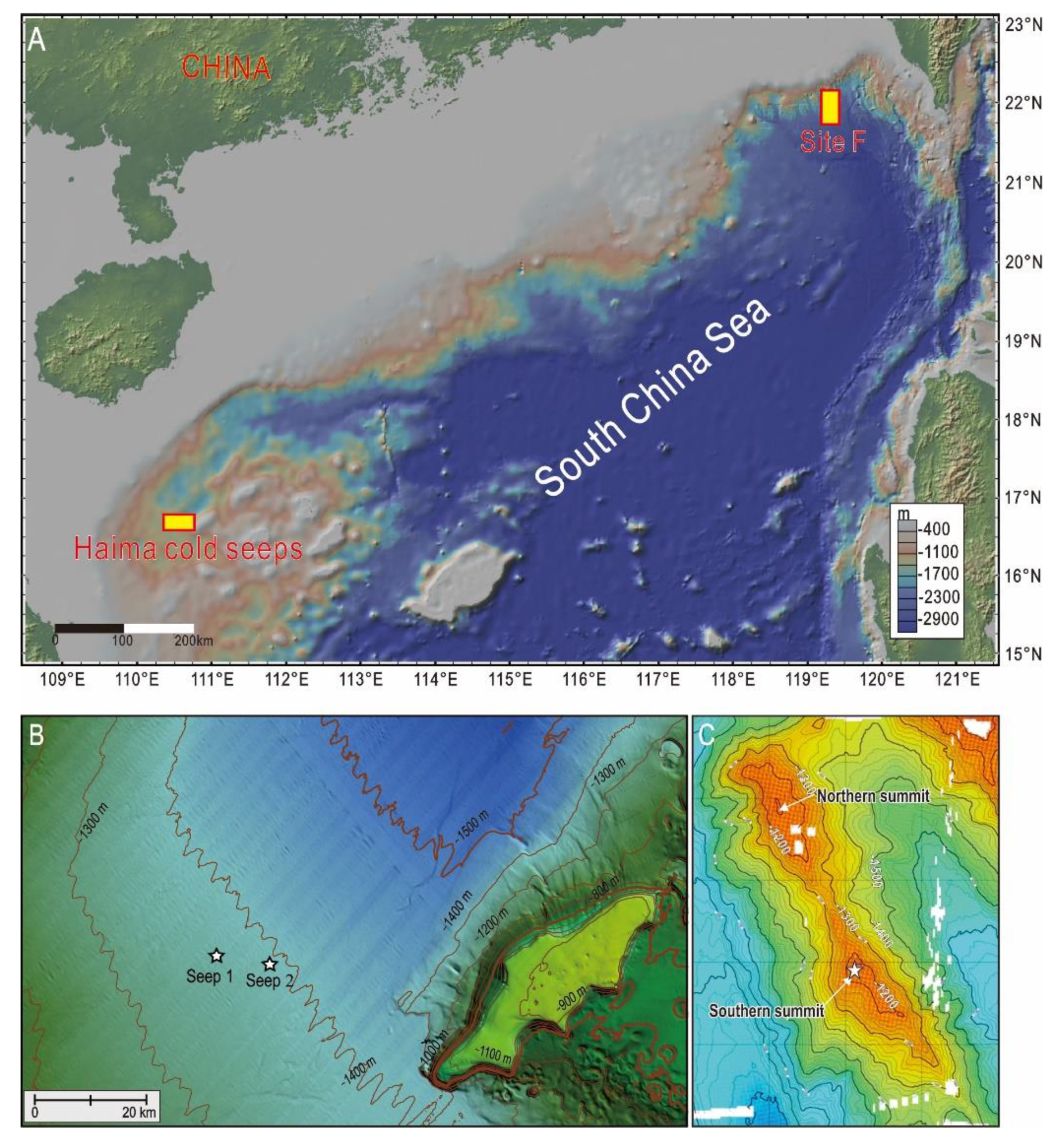
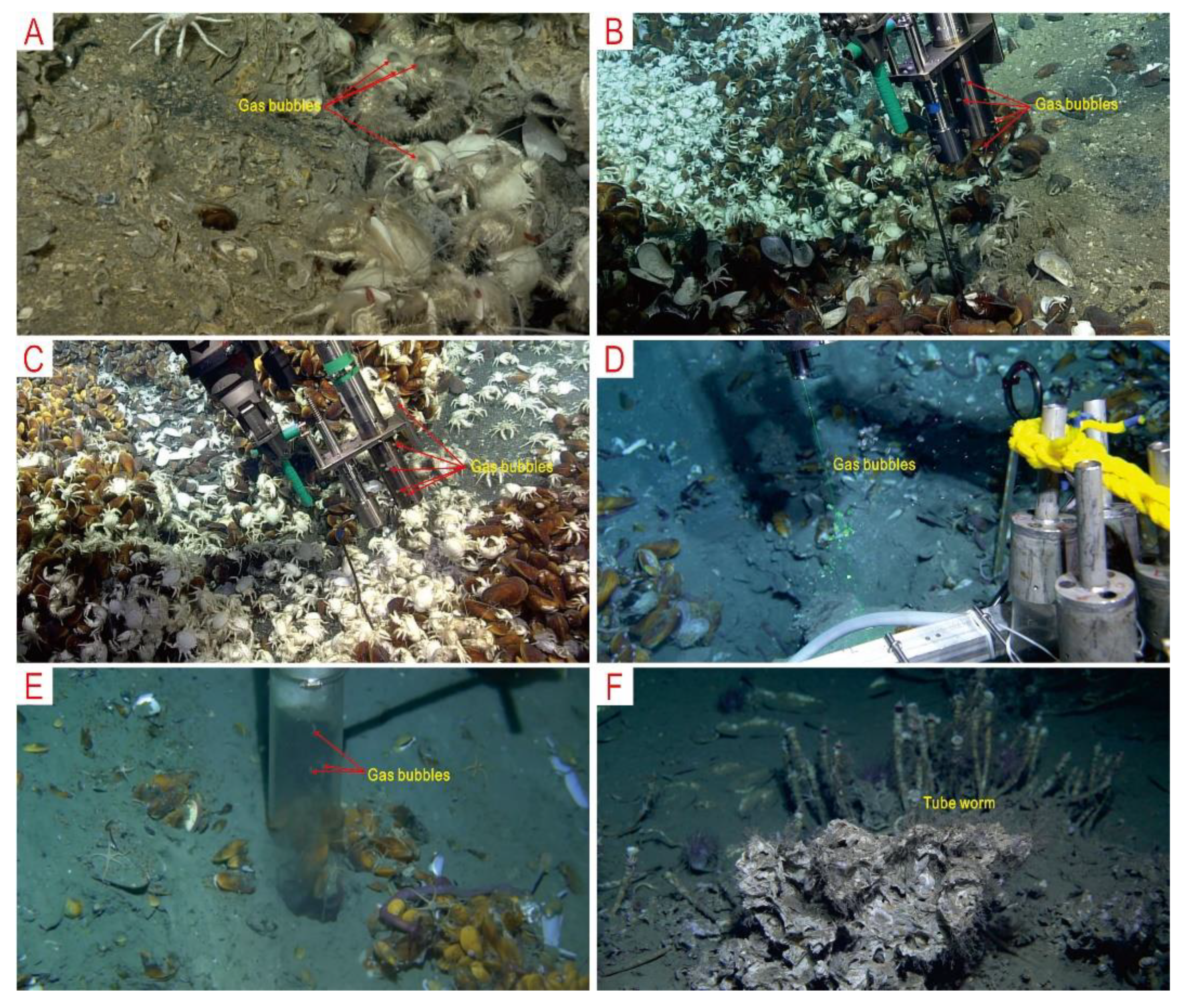
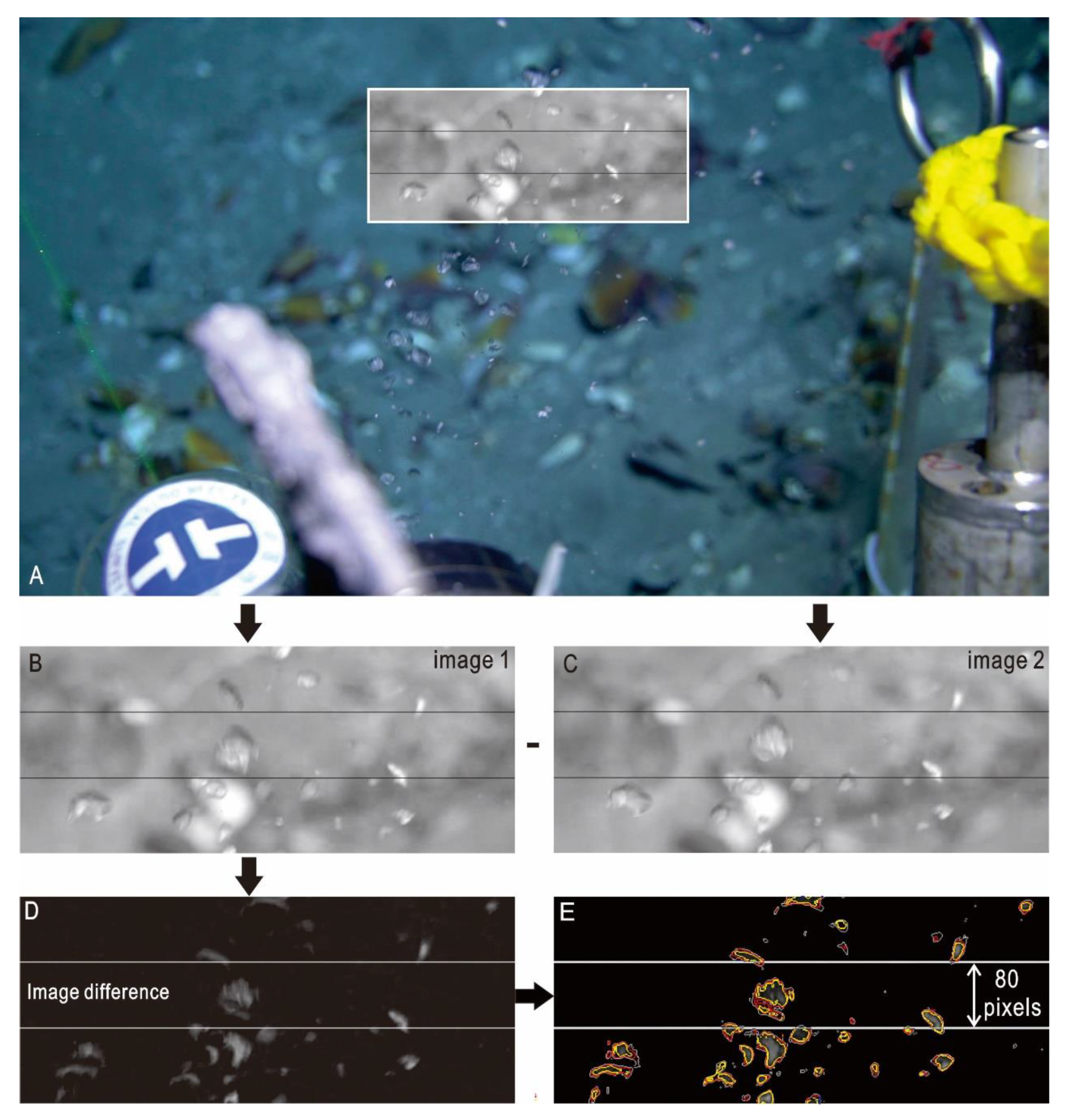
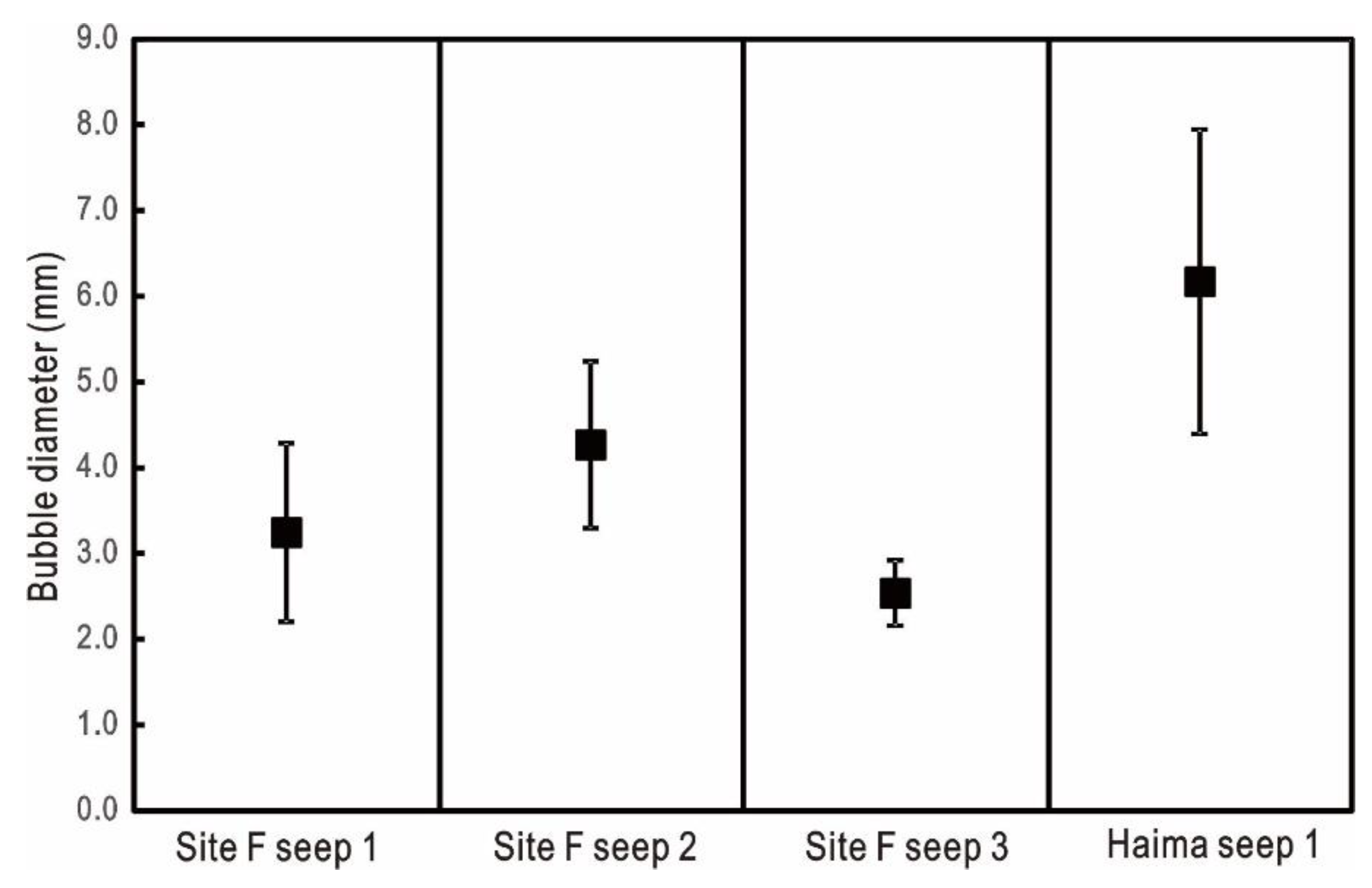

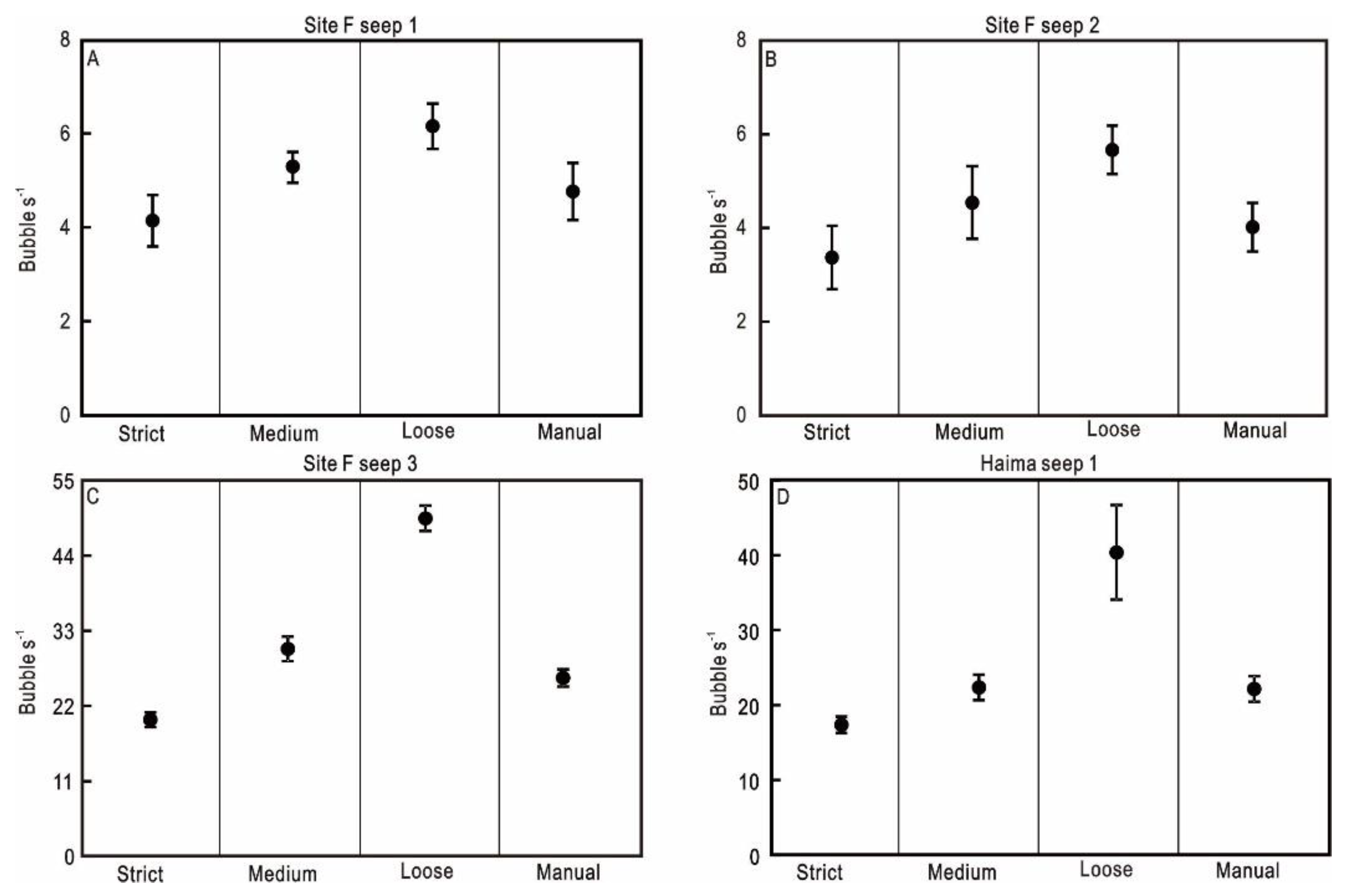
| Site | Seep | Depth (m) | Sampling Frequency (s) | Data Range (min) | Activity Type | Seep Type | Release Rate (Bubbles s−1) | Avg. Bubble Diameter (mm) | Bubble Volume at Depth (mm3) | Gas Amount per Bubble (mol) | Annual Release (mol yr−1) | Annual Release (m3 yr−1) | Annual Mass Flow (T yr−1) |
|---|---|---|---|---|---|---|---|---|---|---|---|---|---|
| Site F | Seep 1 | 1125 | 10 | 10 | discontinuous | Gaseous | 4.8 ± 0.61 | 3.25 ± 1.04 | 23.42 ± 21.02 | 1.43 × 10−4 ± 1.28 × 10−4 | 2.16 × 104 | 3.55 | 0.35 |
| seep 2 | 1127 | 20 | 20 | continuous | Gaseous | 26.1 ± 0.67 | 4.27 ± 0.97 | 47.25 ± 33.72 | 2.88 × 10−4 ± 2.05 × 10−4 | 2.37 × 105 | 38.9 | 3.79 | |
| seep 3 | 1124 | 15 | 10 | continuous | Gaseous | 4.0 ± 0.52 | 2.54 ± 0.38 | 9.11 ± 3.92 | 5.55 × 10−5 ± 2.39 × 10−5 | 7.00 × 103 | 1.15 | 0.11 | |
| Haima | seep 1 | 1395 | 10 | 20 | continuous | Gaseous | 22.4 ± 1.69 | 6.17 ± 1.78 | 156.07 ± 149.6 | 1.20 × 10−3 ± 1.15 × 10−3 | 8.48 × 105 | 110 | 13.5 |
| seep 2 | 1382 | 10 | 4 | continuous | Gaseous | - | - | - | - | - | - | - |
© 2020 by the authors. Licensee MDPI, Basel, Switzerland. This article is an open access article distributed under the terms and conditions of the Creative Commons Attribution (CC BY) license (http://creativecommons.org/licenses/by/4.0/).
Share and Cite
Di, P.; Feng, D.; Tao, J.; Chen, D. Using Time-Series Videos to Quantify Methane Bubbles Flux from Natural Cold Seeps in the South China Sea. Minerals 2020, 10, 216. https://doi.org/10.3390/min10030216
Di P, Feng D, Tao J, Chen D. Using Time-Series Videos to Quantify Methane Bubbles Flux from Natural Cold Seeps in the South China Sea. Minerals. 2020; 10(3):216. https://doi.org/10.3390/min10030216
Chicago/Turabian StyleDi, Pengfei, Dong Feng, Jun Tao, and Duofu Chen. 2020. "Using Time-Series Videos to Quantify Methane Bubbles Flux from Natural Cold Seeps in the South China Sea" Minerals 10, no. 3: 216. https://doi.org/10.3390/min10030216
APA StyleDi, P., Feng, D., Tao, J., & Chen, D. (2020). Using Time-Series Videos to Quantify Methane Bubbles Flux from Natural Cold Seeps in the South China Sea. Minerals, 10(3), 216. https://doi.org/10.3390/min10030216





